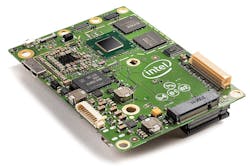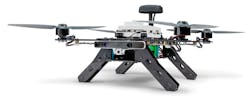The upcoming Consumer Electronics Show will likely have a bunch of new drones for next year, but if you’re down to the wire looking for a holiday purchase, some of the systems below may be of interest. Many of these were at this year’s AUVSI Xponential show.
Keep in mind, though, that in the United States, drone licensing has come and gone and come back again. Likewise, a commercial license is needed if you plan on doing work for hire with drones.
Speaking of work, outfits like Parrot are delivering bundles for chores that range from mapping farmland to generating 3D images of buildings using drones (Fig.1). The Bebop-Pro 3D is priced at $1,099 and includes a Bebop 2 drone, Skycontroller, Pix4Dmodel software with a one year subscription, and a backpack to carry the system in. It creates 3D models by flying around taking photos that are processed by the software to generate a 3D model.
1. The Bebop-Pro 3D flies around a structure grabbing enough photos to allow the analysis software to generate a 3D map of the structure.
DJI is selling a range of drones, from the $399 Spark (Fig. 2) to the radar-equipped, 8-blade AGRAS MG-1S copter that targets agriculture applications. The Spark includes Intel’s Movidius machine learning chip. It has a 16-minute flight time and a 12 Mpixel camera that is also used for object identification and visual command processing. The latter lets user gestures make the drone move or take photos. Of course, like many drones these days, it can also be controlled using an app on a smartphone or tablet.
2. The DJI Spark’s camera has its video stream run through Intel’s Movidius machine learning chip to allow it to recognize control gestures from users.
UDIRC has a variety of drones like the tiny, inexpensive ($49) Firefly (Fig. 3). It comes with its own controller and USB charging cord. The camera can shoot VGA video or single images. It has a flight time of six minutes and weighs only 24 g. The controller runs on AA batteries, while the quadcopter has its own 180 mAh LiPo battery.
3. UDIRC’s tiny Firefly is only $49 and can record VGA resolution video.
There are quite a few quadcopters on the market like the Firefly, and with similar stats. They are cropping up everywhere from drugstores to toy stores. Most use ducted fans to protect the drone propellers and nearby people and objects from the fast-moving blades.
For only $10 more, you can get the foldable IUDIWING D/U29 (Fig. 4) from UDIRC. The arms of this quadcopter flip in to reduce its size during storage. It is a bit heavier at 96.2 g and has a seven-minute flying time. The 720p video camera has a 120-deg. field-of-view (FOV) and an f/2.0 lens. The drone can be controlled by an iOS or Android app providing a live view mode, which operates at 20 frames/s.
4. UDIRC’s IUDIWING D/U29 quadcopter folds into a more compact form for storage and transportation. It can record 720p video.
The Yuneec Typhoon G is an older quadcopter that you can still find for sale. It is designed to use a GoPro camera like the Hero4. This has the advantage of using different cameras compared to an integrated camera. The newer Typhoon 4K is probably a better bet with an integrated, gimbaled 4K camera (Fig. 5). It has similar flight characteristics, being based on the same airframe. The 5400 mA LiPo battery delivers up to 25 minutes of flying time.
5. Yuneec Typhoon G Quadcopter’s gimbaled camera can shoot 4K videos.
The removable camera can record 12 Mpixel photos or video up to 30 frames/s at 4K or 120 frame/s at 1,080p. It is controlled by a ground station with its own 5.5-in touchscreen. The Typhoon 4K also comes with Steadygrip. This is a handheld mount for the camera so you can record smooth video on the ground. Other platforms in this class include the DJI Phantom 3.
Happy Hacking
Most will want to use their new drone to fly and shoot videos. On the other hand, getting inside and customizing a drone will be of interest to many engineers and programmers. There are a number of options available, ranging from the tiny CrazyFlie 2.0 from Bitcraze to Intel’s Intel Aero Compute Board (Fig. 6). The CrazyFlie code is written in C, but there is an Ada version of the code for the CrazyFlie available.
6. The Intel Aero Compute Board is an open-source platform for building drones.
The Aero Compute Board is an open-source platform for building drones (Fig. 7). It is designed to support a range of sensors, including the firm’s RealSense technology. The board is based on a quad-core, Atom x7-Z8750 processor with 4 GB of LPDDR3, 32 GB of eMMC flash, and a dual-band Wireless-AC 8260 with 802.11ac support using a 2×2 MIMO configuration. It includes MIPI CSI-2 camera interfaces. The board can be used for a range of robotic projects, not just in drones.
7. The Intel Aero Ready to Fly Drone is a quadcopter that integrates the Intel Aero Compute Board and a RealSense sensor.
The open-source platform runs Linux. The matching flight controller comes preprogrammed with Dronecode PX4 from the Dronecode and PX4 projects. PX4 autopilot is the core of the Dronecode project.
Developers do not have to start from scratch. There is the AirMap SDK that consists of a number of modules and interfaces, including the Pilot API, the Status API that supports geofencing, and the Flight API. The Flight API will support the Digital Notice and Awareness System (D-NAS).
As mentioned, the 2018 CES will be host to a whole new crop of drones, but most won’t be out until next year. Happy shopping if you are planning on something near-term. We will be reporting from CES 2018 in January.









